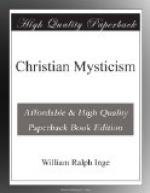We must next consider briefly the charge of Pantheism, which has been flung rather indiscriminately at nearly all speculative mystics, from Plotinus to Emerson. Dionysius, naturally enough, has been freely charged with it. The word is so loosely and thoughtlessly used, even by writers of repute, that I hope I may be pardoned if I try to distinguish (so far as can be done in a few words) between the various systems which have been called pantheistic.
True Pantheism must mean the identification of God with the totality of existence, the doctrine that the universe is the complete and only expression of the nature and life of God, who on this theory is only immanent and not transcendent. On this view, everything in the world belongs to the Being of God, who is manifested equally in everything. Whatever is real is perfect; reality and perfection are the same thing. Here again we must go to India for a perfect example. “The learned behold God alike in the reverend Brahmin, in the ox and in the elephant, in the dog and in him who eateth the flesh of dogs.[181]” So Pope says that God is “as full, as perfect, in a hair as heart.” The Persian Sufis were deeply involved in this error, which leads to all manner of absurdities and even immoralities. It is inconsistent with any belief in purpose, either in the whole or in the parts. Evil, therefore, cannot exist for the sake of a higher good: it must be itself good. It is easy to see how this view of the world may pass into pessimism or nihilism; for if everything is equally real and equally Divine, it makes no difference, except to our tempers, whether we call it everything or nothing, good or bad.
None of the writers with whom we have to deal can fairly be charged with this error, which is subversive of the very foundations of true religion. Eckhart, carried away by his love of paradox, allows himself occasionally to make statements which, if logically developed, would come perilously near to it; and Emerson’s philosophy is more seriously compromised in this direction. Dionysius is in no such danger, for the simple reason that he stands too near to Plato. The pantheistic tendency of mediaeval Realism requires a few words of explanation, especially as I have placed the name of Plato at the head of this Lecture. Plato’s doctrine of ideas aimed at establishing the transcendence of the highest Idea—that of God. But the mediaeval doctrine of ideas, as held by the extreme Realists, sought to find room in the summum genus for a harmonious coexistence of all things. It thus tended towards Pantheism;[182] while the Aristotelian Realists maintained the substantial character of individuals outside the Being of God. “This view,” says Eicken, “which quite inverted the historical and logical relation of the Platonic and Aristotelian philosophies, was maintained till the close of the Middle Ages.”




